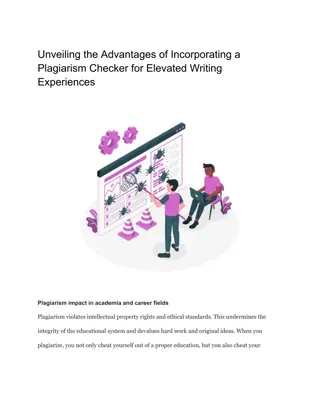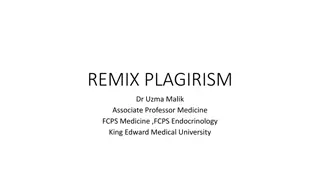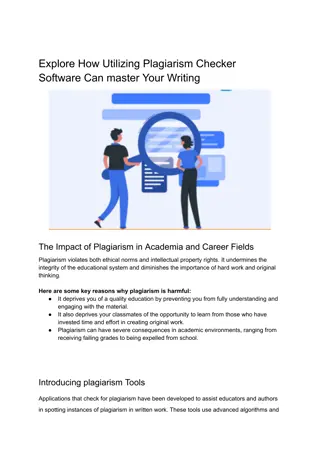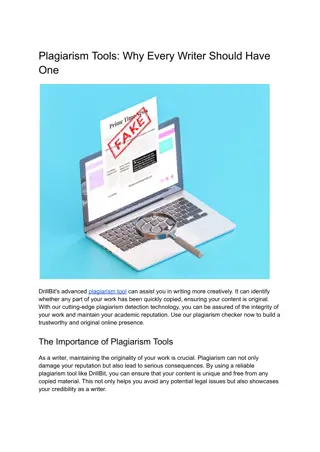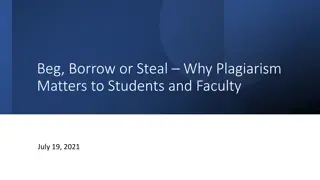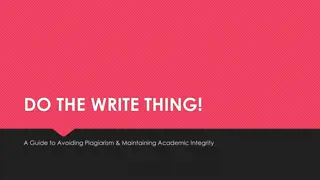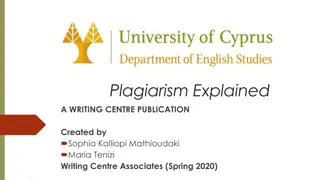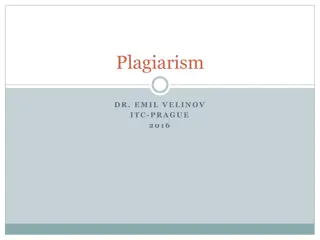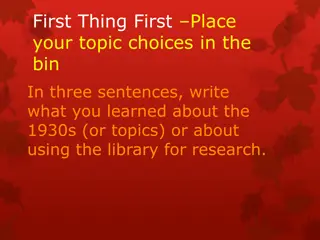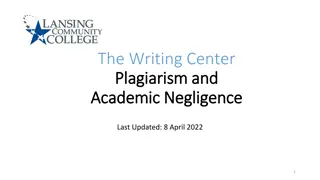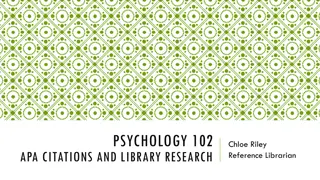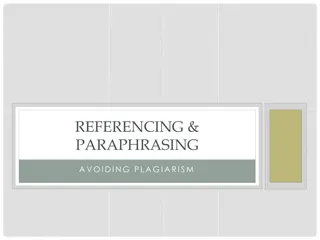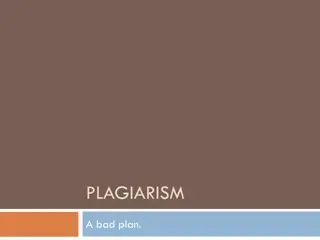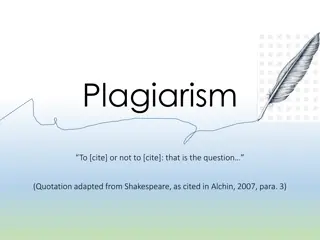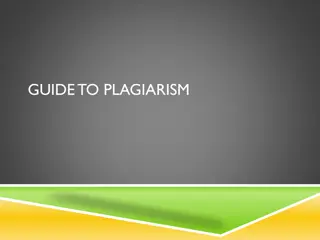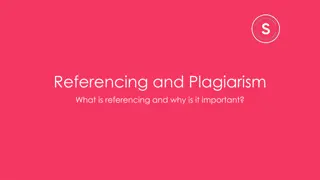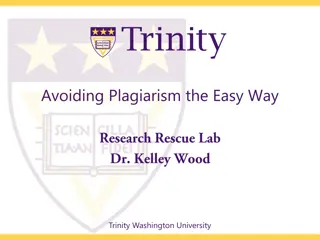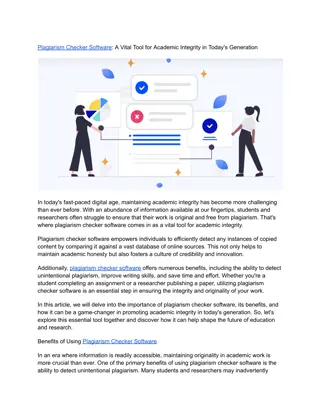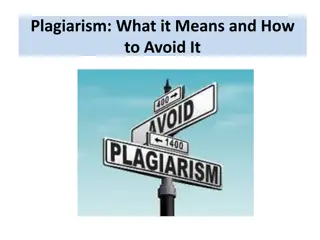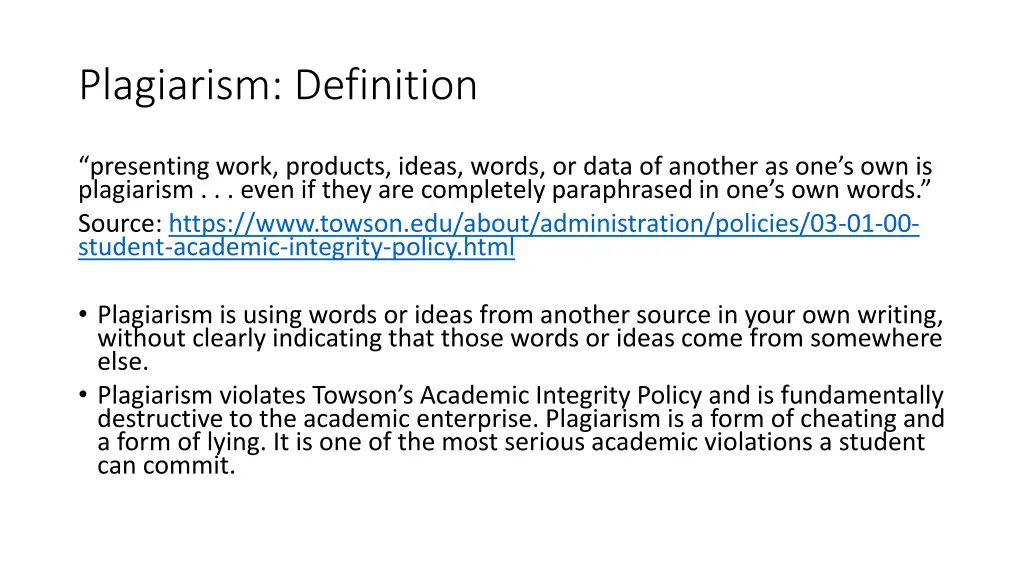
Understanding and Avoiding Plagiarism in Academic Writing
Learn about the definition of plagiarism, its consequences, and how to avoid it. Explore ethical citation practices and the importance of proper attribution in academic work.
Download Presentation

Please find below an Image/Link to download the presentation.
The content on the website is provided AS IS for your information and personal use only. It may not be sold, licensed, or shared on other websites without obtaining consent from the author. If you encounter any issues during the download, it is possible that the publisher has removed the file from their server.
You are allowed to download the files provided on this website for personal or commercial use, subject to the condition that they are used lawfully. All files are the property of their respective owners.
The content on the website is provided AS IS for your information and personal use only. It may not be sold, licensed, or shared on other websites without obtaining consent from the author.
E N D
Presentation Transcript
Plagiarism: Definition presenting work, products, ideas, words, or data of another as one s own is plagiarism . . . even if they are completely paraphrased in one s own words. Source: https://www.towson.edu/about/administration/policies/03-01-00- student-academic-integrity-policy.html Plagiarism is using words or ideas from another source in your own writing, without clearly indicating that those words or ideas come from somewhere else. Plagiarism violates Towson s Academic Integrity Policy and is fundamentally destructive to the academic enterprise. Plagiarism is a form of cheating and a form of lying. It is one of the most serious academic violations a student can commit.
Plagiarism in This Class Students who are caught plagiarizing in this class will receive an F grade for the entire course, and the incident will be reported to the Office of Student Accountability & Restorative Practices (SARP), which may assess additional penalties up to and including expulsion. Unintentional plagiarism is still plagiarism and carries the same penalty. It is the academic equivalent of criminal negligence. In this class, offenses will be judged primarily by the documented severity of the plagiarism itself, not on the student s intentions. Students are morally responsible for making sure they understand how to avoid plagiarism. If you do not fully understand, it is your responsibility to ask the professor or the Writing Center for help before turning in an assignment.
Avoiding Plagiarism Many students plagiarize when they feel overwhelmed by too much work. The right way to deal with this situation is to tell your professor and ask for help. When surfing the internet looking for help or inspiration with your paper, keep a record of every URL you visit. Put these in a list of Works Consulted. Any time you quote or paraphrase material, or even just write down an idea from a website or other source, make a note of where that material came from. Never mix up notes on your own ideas with your notes on other people s work. When in doubt as to whether a citation is necessary (e.g. whether a piece of information is common knowledge ), it is always safer to cite.
Ethical Citation: What/Why WHAT Cite any borrowed words, ideas, work, pictures, data, etc. Except common knowledge (non-debatable facts your audience should know without having to look up). When in doubt, cite! WHY Honesty: Don t pretend you did work you didn t do. Learning: You are not honing your skills if you outsource the work. Gratitude: When someone else s work makes your work better, or saves you time and effort, you should want to thank them.
Ethical Citation: How Format must make clear EXACTLY: Where other people s words or ideas begin and end. Where the borrowed material comes from. All borrowings followed by parenthetical citation: Contains minimum info needed to find source s full bibliographic entry (typically the author s last name). Contains locator number(s) to pinpoint quotation within source (e.g. page or line #s). Full information for source in Works Cited at end of paper. In some styles, this info may go in a footnote/endnote.
Ethical Citation: How Borrowing words: Any borrowed words must be inside quotation marks. Parenthetical citation at end of quote (or of the sentence containing quotes). Borrowing ideas: Includes summarizing, paraphrasing, putting things into your own words. No quotation marks but must label beginning and end! Begin sections of paraphrase with verbal tag, like So-and-so argues that . . . End sections of paraphrase with a parenthetical citation. Other forms of help received or work borrowed: Explain in a footnote/endnote.
AI Tools and Plagiarism Whats Not New AI tools do not invalidate our existing definitions of plagiarism or present radically new ethical questions for students. Ethically, AI-generated text is simply a source like any other. The question, as always, is whether you are claiming to have done work (produced words or ideas) that actually came from somewhere else.
AI Tools and Plagiarism Whats New AI plagiarism is more tempting because: It is much easier for students to get many different kinds of help, including help that formerly required a live person. It is harder for teachers to prove that it happened. The convenience of AI tools and the range of ways they can be used does mean that students will have to think harder about how to use them ethically. The norms for both using and citing AI are still in flux and could vary tremendously from one course or semester to another. The technology itself and what it can do is also rapidly evolving.
AI Tools: Ethical Citation and Use For me, ALWAYS cite any use of AI tools that helped you write your paper. When quoting or paraphrasing AI-generated words or ideas, cite as you would any other source. See https://style.mla.org/citing-generative-ai/. For ALL OTHER uses of AI tools (i.e. where there isn t a clearly demarcated passage that you can put an in-text citation on), include a footnote/endnote explaining exactly what you did. To think about whether your use of AI is appropriate, ask yourself: 1. Would my professor be okay with me getting the same help from a classmate or writing tutor? (TU s Writing Center has guidelines for what kinds of help its tutors ethically can and cannot give). 2. How would my professor want me to document this help? 3. At the end of the day, did I honestly do all the work my professor expected me to do? Have I practiced the skills I was supposed to practice? Are the words and ideas my words and ideas (or clearly cited)?
AI Tools: Possible Uses Answering concrete questions or explaining key concepts related to the texts you are reading or the essay-writing process (like a fancy google or Wikipedia). Making a basic argument about a topic to help you come up with a better one. Offering counter-arguments to your thesis for you to consider responding to. Finding passages relevant to a theme (BUT be aware it usually misses important passages and can invent nonexistent ones). Basic proofreading (correcting specific grammar and spelling errors). Suggesting stylistic improvements to your writing (BUT don t overuse, make sure what you turn in still sounds like you, and explain what you did in a note). NOTE: These tools, and the norms surrounding their use in schools, are new and rapidly evolving. Our ideas about acceptable uses may change.
AI Tools: Limitations AI chatbots based on LLMs (Large Language Models) are fundamentally bullshit generators. They say things that sound normal and plausible based on the texts they were trained on. They cannot understand what they are saying or determine if it is true. Therefore, they usually present the conventional wisdom on a topic. At the opposite extreme, they can randomly make things up ( hallucinate ). Therefore, never rely on the factual accuracy of AI-generated text. In particular, never trust AI-generated quotations or citations! Always check them against the original source.
AI Tools: Consider the Ethics of These Examples Should you do it? How should you cite it? Asking AI to summarize common interpretations of a text to jumpstart your thinking on the paper. Asking AI for a thesis and then writing your own paper based on that. Rewriting AI-generated text (i.e. putting it into your own words) and including it in the paper. The same thing, but you are adding and modifying some of the AI content. Asking AI to fix spelling and punctuation errors in your paper. Asking AI to point out grammatical errors in your paper. Asking AI to rewrite part or all of your paper to make it more grammatical or flow more smoothly.

